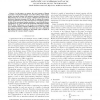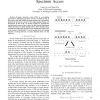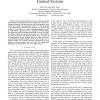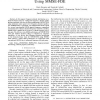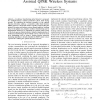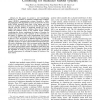ICC
2008
IEEE
14 years 10 months ago
2008
IEEE
— In this paper, we propose the novel concept of Repeat Accumulate Code Division Multiple Access (RA-CDMA), which employs unique, user-specific channel code generator matrices (...
ICC
2008
IEEE
14 years 10 months ago
2008
IEEE
—Dynamic spectrum access (DSA) is a promising approach for mitigating spectrum scarcity. Underlying DSA is the need for fast and reliable spectrum sensing over a potentially larg...
ICC
2008
IEEE
14 years 10 months ago
2008
IEEE
— We introduce a hypergraph based interference model for scheduling in wireless networks. As a generalization of the graph model, hypergraph considers the conflicts caused by su...
ICC
2008
IEEE
14 years 10 months ago
2008
IEEE
—We investigate multiuser two-way relaying strategies for interference limited systems where multiple pairs of users exchange information with their partners via an intermediate ...
ICC
2008
IEEE
14 years 10 months ago
2008
IEEE
ICC
2008
IEEE
14 years 10 months ago
2008
IEEE
—In this paper, frequency-domain interleaving on a frame-by-frame basis for orthogonal frequency division multiplexing combined with time division multiplexing (OFDM/TDM) using m...
ICC
2008
IEEE
14 years 10 months ago
2008
IEEE
Abstract— It has been demonstrated that base station cooperation can reduce co-channel interference (CCI) and increase cellular system capacity. In this work we consider another ...
ICC
2008
IEEE
14 years 10 months ago
2008
IEEE
— A nonlinear beamforming aided detector is proposed for multiple-antenna assisted quadrature phase shift keying systems. By exploiting the inherent symmetry of the optimal Bayes...
ICC
2008
IEEE
14 years 10 months ago
2008
IEEE
A common technique for wireless positioning is to estimate time-of-arrivals (TOAs) of signals traveling between a target node and a number of reference nodes, and then to determin...
ICC
2008
IEEE
14 years 10 months ago
2008
IEEE
— In this paper, we present a new beamforming scheme for a downlink of multiuser multiple-input multipleoutput (MIMO) communication systems. Recently, a blockdiagonalization (BD)...
